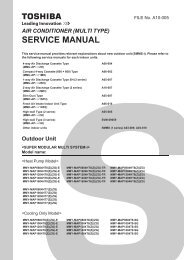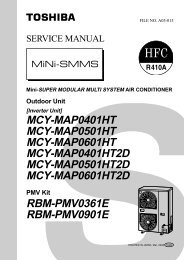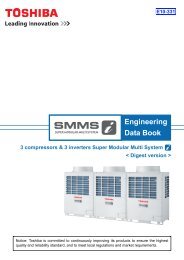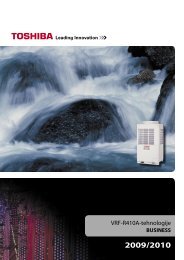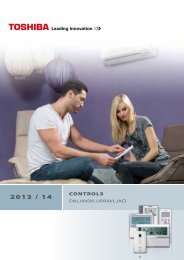You also want an ePaper? Increase the reach of your titles
YUMPU automatically turns print PDFs into web optimized ePapers that Google loves.
5. REFRIGERANT PIPING DESIGN1. Warnings on refrigerant leakage ImportantCheck of Concentration LimitThe room in which the air conditioner is to be installedrequires a design that in the event of refrigerant gasleaking out, its concentration will not exceed a setlimit.The refrigerant R410A which is used in the air conditioneris safe, without the toxicity or combustibility ofammonia, and is not restricted by laws to be imposedwhich protect the ozone layer. However, since it containsmore than air, it poses the risk of suffocation if itsconcentration should rise excessively. Suffocation fromleakage of R410A is almost non-existent. With the recentincrease in the number of high concentration buildings,however, the installation of multi air conditioner systemsis on the increase because of the need for effective useof floor space, individual control, energy conservation bycurtailing heat and carrying power etc.Most importantly, the multi air conditioner system is ableto replenish a large amount of refrigerant compared withconventional individual air conditioners. If a single unitof the multi conditioner system is to be installed in asmall room, select a suitable model and installationprocedure so that if the refrigerant accidentally leaksout, its concentration does not reach the limit (and in theevent of an emergency, measures can be made beforeinjury can occur).In a room where the concentration may exceed the limit,create an opening with adjacent rooms, or installmechanical ventilation combined with a gas leakdetection device.The concentration is as given below.Total amount of refrigerant (kg)Min. volume of the indoor unit installed room (m³)≤ Concentration limit (kg/m³)The concentration limit of R410A which is used in multiair conditioners is 0.3kg/m³.NOTE 1 :If there are 2 or more refrigerating systems in a singlerefrigerating device, the amounts of refrigerant shouldbe as charged in each independent device.e.g., chargedamount (10kg)Outdoor unite.g.,charged amount (15kg)Room A Room B Room C Room D Room E Room F<strong>Indoor</strong> unitFor the amount of charge in this example:The possible amount of leaked refrigerant gas inrooms A, B and C is 10kg.The possible amount of leaked refrigerant gas inrooms D, E and F is 15kg.NOTE : 2The standards for minimum room volume are as follows.(1) No partition (shaded portion)(2) When there is an effective opening with the adjacentroom for ventilation of leaking refrigerant gas(opening without a door, or an opening 0.15% orlarger than the respective floor spaces at the top orbottom of the door).Outdoor unitRefrigerant piping<strong>Indoor</strong> unit(3) If an indoor unit is installed in each partitioned roomand the refrigerant tubing is interconnected, thesmallest room of course becomes the object. Butwhen a mechanical ventilation is installed interlockedwith a gas leakage detector in the smallestroom where the density limit is exceeded, thevolume of the next smallest room becomes theobject.Refrigerant pipingVerysmallroomSmallroomMediumroomLarge roomMechanical ventilation device - Gas leak detectorOutdoor unit<strong>Indoor</strong> unitNOTE 3 :The minimum indoor floor area compared with theamount of refrigerant is roughly as follows:(When the ceiling is 2.7m high)m² 35Min. indoor floor area40302520151050Range below thedensity limitof 0.3 kg/m³(countermeasuresnot needed)Range abovethe density limitof 0.3 kg/m³(countermeasuresneeded)10 20 30Total amount of refrigerantkg23



